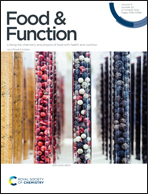Reduction of intestinal fat digestion and absorption by β-glucan secreted by Rhizobium pusense via interference in triglyceride hydrolysis†
Abstract
In this study, the ability of β-glucan extracted from Rhizobium pusense to reduce digestion and absorption of ingested fat was systematically investigated via in vitro and in vivo experiments. Specifically, in in vitro gastrointestinal simulations, when β-glucan was added to a high-fat food model, the concentration of free fatty acids (FFAs) were remarkably decreased. An in vitro intestinal epithelial cell model demonstrated that addition of β-glucan can significantly reduce the translocation of triglycerides (TGs) and FFAs. In in vivo experiments, a high-fat food model with the addition of β-glucan showed a significant reduction in postprandial serum TG elevation. Confocal laser scanning microscopy analysis showed that when β-glucan was added to a cream sample, both coalescence and disappearance of lipid droplets were reduced, and the distribution of oil droplets was very consistent with the distribution of β-glucan positions. This suggests the main mechanism for this effect: the coagulation of lipid droplets by β-glucan leads to a reduction in the available surface area for lipase binding. All these findings suggest that β-glucan could potentially be used as a food additive or supplement to reduce the absorption of ingested fat and thus aid in weight loss and the treatment of diseases caused by TGs.



 Please wait while we load your content...
Please wait while we load your content...